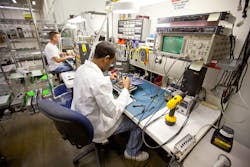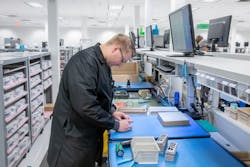Engineers Look to Adopt a More Sustainable Approach to Electronic Design
What You'll Learn:
- Why a majority of engineers are looking to implement sustainability in their design approaches.
- How to design for sustainability, from reuse and recycling to power efficiency.
- Creating a new supply chain for the circular economy.
Up to 80% of any electronic product’s environmental impact is locked in at the design stage of a project, according to estimates by the European Commission. Decisions made early in the development process can influence how long the device can last, whether it’s able to be repaired and what will happen to it at the end of its life.
That being the case, electrical engineers now find themselves at the front lines of the effort to create a more circular economy for the electronics industry and stem the tide of electronic waste piling up the world over. According to Avnet, one of the world’s largest electronic distributors, engineers are already changing how they design electronic devices and systems to be more sustainable over the long term.
Stacy Mendez, Avnet’s director of global strategic planning and ESG, said not everyone in the electronics industry sees the potential in designing products in a more sustainable way. But according to a recent survey of customers from its global database, Avnet uncovered that a solid majority (78%) of those who do are taking steps to implement it in their plans, and that the shift is largely being driven by customer demand.
The survey results revealed that engineers continue to make progress when it comes to building products that are more durable, reliable, upgradable and repairable, as well as easier to recycle, refurbish and reuse once they reach the end of their useful life. Besides building products to last longer before they have to be repaired or replaced, they’re also engineering them to be more power efficient over their lifecycle.
Sustainability is becoming a bigger focus for semiconductor makers and other component suppliers. But Mendez, who leads Avnet’s efforts to integrate more sustainable practices into its business, said the survey shows “efforts around sustainable design are further ahead than we may have anticipated.”
Why Sustainable Electronic Design is in Focus
Given everything the electronic industry has been working through in recent years, sustainability has not been as high on the priority list for engineers, noted Mendez.
For the last three years, electronics engineers have been busy trying to navigate supply-chain disruptions due to the pandemic and ongoing shortages of chips and other components. Procuring virtually any part—or even appropriate replacements—has been a huge challenge. But the shortages are abating and order times for components continue to improve, giving engineers more time to focus on other matters.
“As the pandemic-related supply-chain challenges lessen, there is an opportunity to refocus on sustainable design efforts, even though the methods to address it throughout the lifecycle are relatively new,” said Mendez, adding that lead times for chips and other electronic components are trending down. “This improvement in lead times is allowing for sustainable design to move up engineers’ priority lists.”
Driving the focus on more sustainable product design is, by far, customer demand, according to Avnet. Four out of every 10 engineers said customer pressure will be the most effective driver for them to adopt a more sustainable approach to electronic design.
The electronics industry is trying to take more responsibility for its environmental impact, and more companies are updating their internal planning and processes to focus on “design for sustainability.” “It is clear that customers are seeking sustainable options, which means demand for sustainably designed products will only continue to grow,” said Mendez. “Engineers should seek opportunities to incorporate sustainable design from the very start of the product development process.”
However, it could take some time for the electronic industry to clean up its act. In 2020, a U.N. report estimated that more than 50 million tons of electronic waste had been dumped globally in 2019 alone, making it one of the fastest-growing streams of waste in the world.
Unless these devices are recycled, they’re otherwise thrown out. The components inside are never reused, and the electricity used throughout its lifecycle is wasted, entering the atmosphere as carbon emissions.
“Design for Sustainability”: The Tactics
According to Mendez, engineers are using a wide range of different tactics to design more sustainable products.
Reuse and recycling are key to the circular economy. But reducing the complexity of product designs and the number of products that are manufactured in the first place can be even more important. Most of a device’s environmental impact stems from extracting, transporting and manipulating the raw materials used to mass-produce it. If the device can last longer before being replaced, less resources are required.
“One thing we do know is that engineers are planning for product longevity,” she said, citing the more than 75% of engineers who “are currently using or planning to implement designs for longevity into their planning.”
Power efficiency is also key to sustainability. It directly corresponds to the amount of electricity a device burns over its lifecycle and the amount of carbon emissions it adds to the atmosphere over time.
As it happens, Avnet revealed that 77% of the respondents are currently using or plan to implement design tactics to reduce power consumption. More than 60% of the engineers said that they’re leveraging software, specifically, to help prolong a device’s energy efficiency and overall lifespan.
More than half of the engineers indicated that they’re taking sustainability to the next level. They have plans to actively design new products for recycling (60%) and reuse (57%), which can include building electronic devices to be more easily upgradable or even refurbished and repaired in the event they malfunction or fail. Repairing or refurbishing devices and extending their lives helps keep them out of landfill. Avnet said about half are currently avoiding the use of non-renewable resources when possible—or plan to.
About 64% leverage, or plan to leverage, wired or wireless connectivity in new product designs, according to Avnet. Many engineers already implement connectivity to meet customer needs anyway, but it’s also relevant for sustainability. For instance, a smart thermostat can detect patterns of when people are present in a room and adjust the temperature so that less power will be used when the area is unoccupied.
According to Mendez, “wireless connectivity helps us get the data to further optimize designs in the future. Some sensors' data can help us better predict when maintenance will be needed and learn patterns that will ultimately help machines run more sustainably.”
Moreover, she pointed out that “all of the data that these sensors can collect can be implemented into future designs and ultimately help engineers design more sustainably.”
A New Supply Chain for the Circular Economy
Designing a product more sustainably is more than sourcing the correct components and then arranging them on a PCB. It requires working closely with companies up and down the supply chain, said Mendez. “The disruption of the past few years has underscored the importance of understanding an organization’s supply chain. There is no such thing as going back to the way it was.”
Visibility into the supply chain is relevant to sustainability because you want to send the correct signals to suppliers and other companies throughout the supply chain about the demand for a new device. The risk, said Mendez, is that suppliers overproduce the parts you need, which can lead to excess carbon emissions from manufacturing and, in turn, create more electronic waste when the product’s useful life finally ends.
According to Avnet, most engineers reported that they’re already taking steps to get more visibility into part availability and lead times (81%) and component end-of-life management (77%), or that they intend to.
Avnet is trying to solve some of the challenges around transparency and traceability by working with its customers to create “digital supply chains.” The goal is to give them access to a wide range of information about the components they’re using, such as a part’s provenance, supplier country of origin, shipping schedules and delivery information throughout the sprawling global supply chains that its customers typically operate.
Sharing such data gives engineers better visibility into the supply chain, which can then be used to make informed decisions during the design phase of a project, including where to and how to source raw materials and when to reuse or recycle a product at the end of its life instead of discarding and replacing it, said Mendez. Data is also useful for companies trying to track the status of their sustainability efforts.
She added, “Because Avnet sits in the middle of the technology value chain, we’re a partner for our customers to help them manage each step of the product development process.” That includes giving them insights into the supply chain and identifying parts that score higher for sustainability, whether they’re recycled or reused parts or ones that can be replaced with relative ease when repairing a device.
Why Component End-of-Life Management is Key
One of the questions facing the electronics industry is whether the concept of a circular economy is even compatible with how the business operates. There may not be much incentive for Avnet and other electronics distributors (that aim to sell as many components as possible) to convince their customers to reduce the complexity of their designs and then reuse or recycle parts at the end of the device’s life.
Still undecided is what to do with electronic products and the components soldered on the PCB once they get to the end of their useful life—called component end-of-life (EOL) management.
Said Mendez, “Designing in sustainable component end-of-life management allows the end-user to either dispose, reuse or recycle components properly. Throughout a product’s lifecycle, multiple suppliers and manufacturers touch that product. Each supplier and manufacturer must ensure their sustainability practices align with those later [or] earlier in the product development lifecycle.
“Therefore, there is a responsibility at every point within the value chain to ensure that sustainable disassembly and disposal of a component or product occurs.”
While engineers are adopting more “design for sustainability” tactics, managing components at the end of their life is a separate issue that not every company is equipped to solve on a large scale. Collecting and dismantling devices, requalifying all of the components that can be saved and recycling everything else can be prohibitively expensive and complex even for the world’s largest electronics companies.
“There will need to be some systemic changes, both easy and revolutionary, that happen before the industry can fully embrace a circular economy,” said Mendez.
This article appeared in Electronic Design, an affiliate publication of Machine Design.


